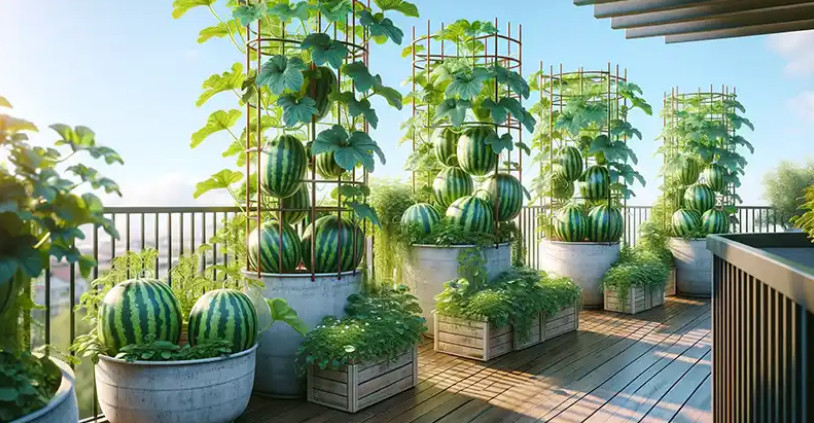Cultivating watermelons in containers is an exciting venture that can yield succulent fruits even in limited spaces. This guide will walk you through the steps to grow watermelons successfully at home using containers:

Size: Choose a container with a minimum capacity of 20 gallons to provide ample room for the sprawling roots of watermelon plants.
Depth: A depth of at least 24 inches is crucial to accommodate the extensive root system of watermelons.
Drainage: Good drainage is key. Ensure your container has several holes at the bottom to prevent excess water accumulation.
Choosing the Right Watermelon Variety:
Container-Suitable Varieties: Opt for miniature or bush types such as ‘Sugar Baby’ or ‘Bush Sugar Baby,’ which are better adapted to container gardening.
Space Considerations: Given the vining nature of watermelons, select a variety that matches your container’s size and your space’s capacity.
Soil and Planting:
Soil Mix: Utilize a nutrient-rich, well-draining potting mix. Incorporate compost or aged manure to enrich the soil with essential nutrients.
Planting Seeds: Plant 2-3 watermelon seeds around 1 inch deep towards the center of the container. Thin out to the strongest seedling once they germinate.
Spacing: For multiple containers, maintain a spacing of at least 2 feet apart to ensure adequate air circulation and sunlight exposure.
Watering and Sunlight:

Watering: Watermelons require consistent moisture. Water deeply while allowing the topsoil to dry out slightly between watering sessions.
Sunlight: Position the container in a location that receives full sun, ideally 8-10 hours of direct sunlight per day, to foster growth and fruit development.
Care and Maintenance:
Support: Implement a sturdy trellis or support framework for the vines to climb. This promotes better air circulation and fruit quality.
Fertilization: Apply a balanced, slow-release fertilizer, or use a water-soluble fertilizer at half strength every 4 weeks. Regularly prune excess vines and leaves to concentrate the plant’s energy on fruit production.
Pest and Disease Management:
Pests: Keep an eye out for common pests such as aphids and spider mites. Employ organic pest control methods like insecticidal soap or neem oil as needed.
Diseases: To combat fungal diseases such as powdery mildew, ensure adequate spacing and air circulation. Use eco-friendly fungicides when necessary.
Harvesting:
Timeline: Watermelons usually mature in 80-100 days, depending on the variety.
Signs of Maturity: A mature watermelon will have a dull sound when tapped and the underside where it rests on the ground will turn from white to a yellowish color.
Harvesting Method: Cut the fruit from the vine carefully with garden shears, leaving a couple of inches of stem attached.

Growing watermelons in containers is a rewarding challenge that emphasizes the importance of container selection, soil preparation, and regular care. While it requires dedication, the joy of harvesting your own juicy watermelons is unparalleled. Embrace the learning curve, and let each growing season bring you new insights and bountiful harvests.
Remember, gardening is a journey of discovery and adaptation. Enjoy the process and the delicious rewards of your efforts!
Inspired by this? Share the article with your friends!


